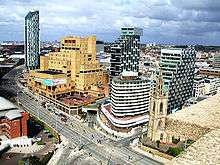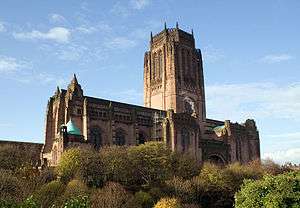Church of Saint John the Baptist, Liverpool
The Church of Saint John the Baptist is on the corner of West Derby Road and Green Lane, in Tuebrook, Liverpool, England. It is recorded in the National Heritage List for England as a designated Grade I listed building,[1] and an active Anglican parish church in the diocese of Liverpool, the archdeaconry of Liverpool and the deanery of West Derby.[2]
| Church of Saint John the Baptist, Liverpool | |
|---|---|
 Church of Saint John the Baptist, Liverpool | |

| |
| OS grid reference | SJ 382 924 |
| Location | Tuebrook, Liverpool |
| Country | England |
| Denomination | Anglican |
| Churchmanship | Anglo-Catholic |
| History | |
| Status | Parish church |
| Architecture | |
| Functional status | Active |
| Heritage designation | Grade I |
| Designated | 28 June 1958 |
| Architect(s) | George Frederick Bodley |
| Architectural type | Church |
| Style | Gothic Revival |
| Groundbreaking | 1867 |
| Completed | 1870 |
| Construction cost | £25,000 |
| Specifications | |
| Materials | Red and buff stone Tile and slate roofs |
| Administration | |
| Deanery | West Derby |
| Archdeaconry | Liverpool |
| Diocese | Liverpool |
| Province | York |
| Clergy | |
| Vicar(s) | Vacant |
| Priest(s) | Canon Christopher Cook |
| Laity | |
| Organist(s) | Daniel Mansfield |
History
The church was built between 1867 and 1870, its cost of £25,000 (equivalent to £2,409,683 in 2019),[3] being totally met by the wife of Revd J. C. Reade. The architect was George Frederick Bodley. The interior was redecorated in 1910 by Henry Hare to Bodley's design. This was restored in 1968–71 by Stephen Dykes Bower.[4]
There was controversy before the church was consecrated because Bodley intended to use an early 16th-century altarpiece from Antwerp which had carved tableaux of the Passion as the reredos. However the Bishop of Chester considered it to be too "Popish" and he refused to consecrate the church until it was removed. The altarpiece is now in St Michael's Church, Brighton.[4]
Architecture
Exterior
The church is built in red and buff stone, which is irregularly banded.[4] The main roof is tiled, while the roofs of the aisles are of slate. Its plan consists of a five-bay nave with a clerestory, north and south aisles under lean-to roofs, a west tower, a north porch, a chancel with a chapel to the north, the organ loft to the south and a detached vestry connected to the chancel by a short passage. The tower has angled buttresses and a west entrance above which is a three-light window. The top stage has two-light louvred bell-openings and a panelled parapet with pinnacles at the corners.[1] The spire is recessed on an octagonal base containing gabled two-light openings and it is attached to the pinnacles by flying buttresses.[1][4] At the south east corner of the tower is a lean-to stair turret. The porch has a flat roof with a parapet and a niche over the entrance containing a statue.[1]
Interior
Pollard and Pevsner describe the interior as being "glorious" and "richly coloured" due to the "resplendent display of Bodley fittings and the vibrant decoration".[4] The citation in the National Heritage List for England states it is "one of the finest examples of Victorian polychromy".[1] The walls and the roofs are all richly stencilled, and in addition there is a wall painting on the east wall of the nave by C. E. Kempe. The gilt reredos dates from 1871 and has panels painted by Kempe.[4]
The area under the tower has made into the Chapel of the Holy Rood and contains a reredos, an altar and a credence table which were adapted in 1978 from a rood screen of 1890 by Bodley which was taken from Dunstable Priory.[1][4] The pulpit and the octagonal font were both designed by Bodley, as were the richly painted screens (again with panels by Kempe). The stained glass in the east window and the south window in the chancel is by Morris & Co.; some of the windows elsewhere are by Burne-Jones. In the church is a brass memorial dating from 1926 by Hare which consists of a life-size figure of Rev. Ralph Brockman. The memorial to the First World War is a statue of Mary, also by Hare; that to the Second World War is a statue of John the Baptist by Sir Ninian Comper.[4] The statue commissioned by Canon Sampson might never have been sculpted, for Comper was initially reluctant to undertake this commission, only relenting at the behest of his son, whom Comper then used as the model.[5]
The three-manual organ was made by William Hill and Sons in 1867 and cleaned and improved by the same company in 1895. It is contained in a "magnificent Bodley case, with embossed display pipes".[6] It was restored in 1991 by David Wells. There is a ring of eight bells which were cast in 1869 by John Warner & Sons.[7]
Images
 View along nave to chancel
View along nave to chancel High altar and reredos
High altar and reredos Detail of reredos
Detail of reredos The ceiling looking west
The ceiling looking west Chapel of the Holy Rood
Chapel of the Holy Rood East window by William Morris Co.
East window by William Morris Co. The Hill organ
The Hill organ
Incumbents
- 1871–1880 Rev J.C.Reade
- 1880–1884 Rev J.Lindsay
- 1884–1892 Fr F.H.Chevenix Trench
- 1892–1895 Fr P.N. Clark
- 1895–1896 Fr H.N.Thompson
- 1896–1925 Fr Ralph T.Brockman
- 1925–1937 Fr Thomas Brancker
- 1937–1946 Fr W.H.Tayler
- 1946–1994 Rev Canon Frank Sampson MA
- 1994–2010 Rev Dr Canon Paul Nener BM BCh FRCS
- 2010 – 2020 Rev Canon Simon J.P. Fisher MA
Organists
- Claude Ridley 1871–1882
- William Faulkes (organist-composer) 1882 – 1886[8]
- R.Cooper ARCO 1896–1900
- Ernest Welsh ARCO 1900–1903
- Mr Tubb (senior) 1903–1933
- C.F. Holt 1935–1953
- Edward Tubb 1953–1956
- C.F. Holt 1956–1966
- David James (Assistant Organist 1966 then Organist from 1973–1982)
- Keith Simpson BA (Hons) Dip HE 1982-1996
- Clive Arnold 2000–2009
- John Peace BA LRAM ARCO 2009–2017
- Nathaniel Hood BA 2017-2019
- Daniel Mansfield BA(Hons), ARSM, MISM 2019-
Vicarage
The original vicarage, (until 2007 - then entrance to the Brockman Hall became the ‘new’ vicarage in 2007 - 2010. Vicarage is now off site: opposite Peter Lloyd's sports centre) was completed in 1890, was also designed by Bodley.[4] It is a Grade II listed building in grey brick with red brick bands and red sandstone dressings. It has three storeys and a tile roof.[9]
References
- Historic England, "Church of St John Baptist, Liverpool (1063778)", National Heritage List for England, retrieved 19 August 2012
- Deanery of West Derby, The Diocese of Liverpool, retrieved 8 October 2008
- UK Retail Price Index inflation figures are based on data from Clark, Gregory (2017). "The Annual RPI and Average Earnings for Britain, 1209 to Present (New Series)". MeasuringWorth. Retrieved 2 February 2020.
- Pollard, Richard; Pevsner, Nikolaus (2006), The Buildings of England: Lancashire: Liverpool and the South-West, New Haven & London: Yale University Press, pp. 477–479, ISBN 0-300-10910-5
- This information given to Neil Mackenzie and John Foulkes (current – July 2012 – trustee of the church) by Canon Sampson (vicar) in 1979
- Liverpool-Tuebrook, St. John, British Institute of Organ Studies, retrieved 8 October 2008
- Liverpool, Tuebrook, S John Bapt, Dove's Guide for Church Bell Ringers, retrieved 8 October 2008
- Dictionary of Organs and Organists. First Edition. 1912. p.273
- Historic England. "Vicarage of Church of St John Baptist, Liverpool (1063779)". National Heritage List for England. Retrieved 19 August 2012.
External links
![]()


